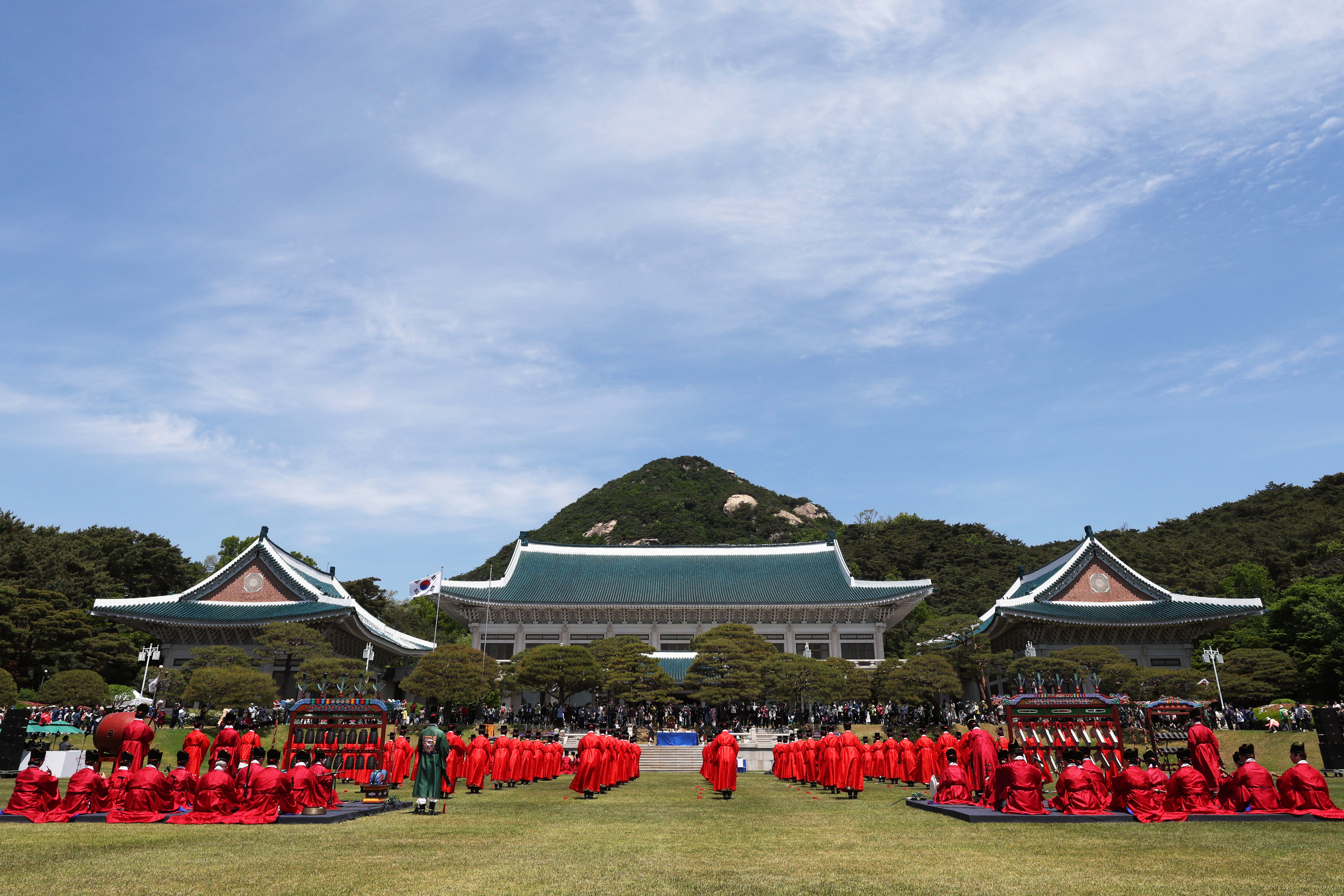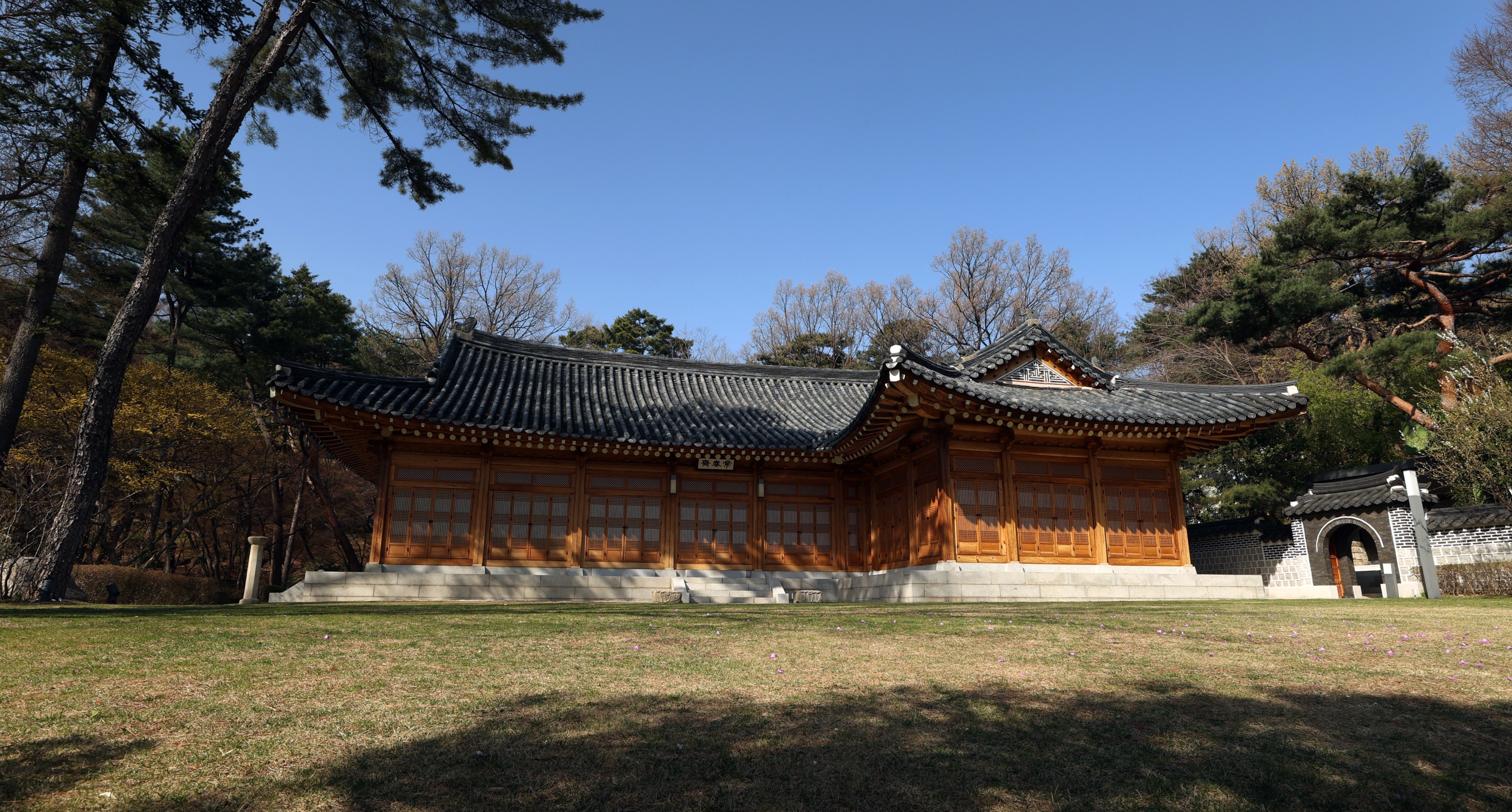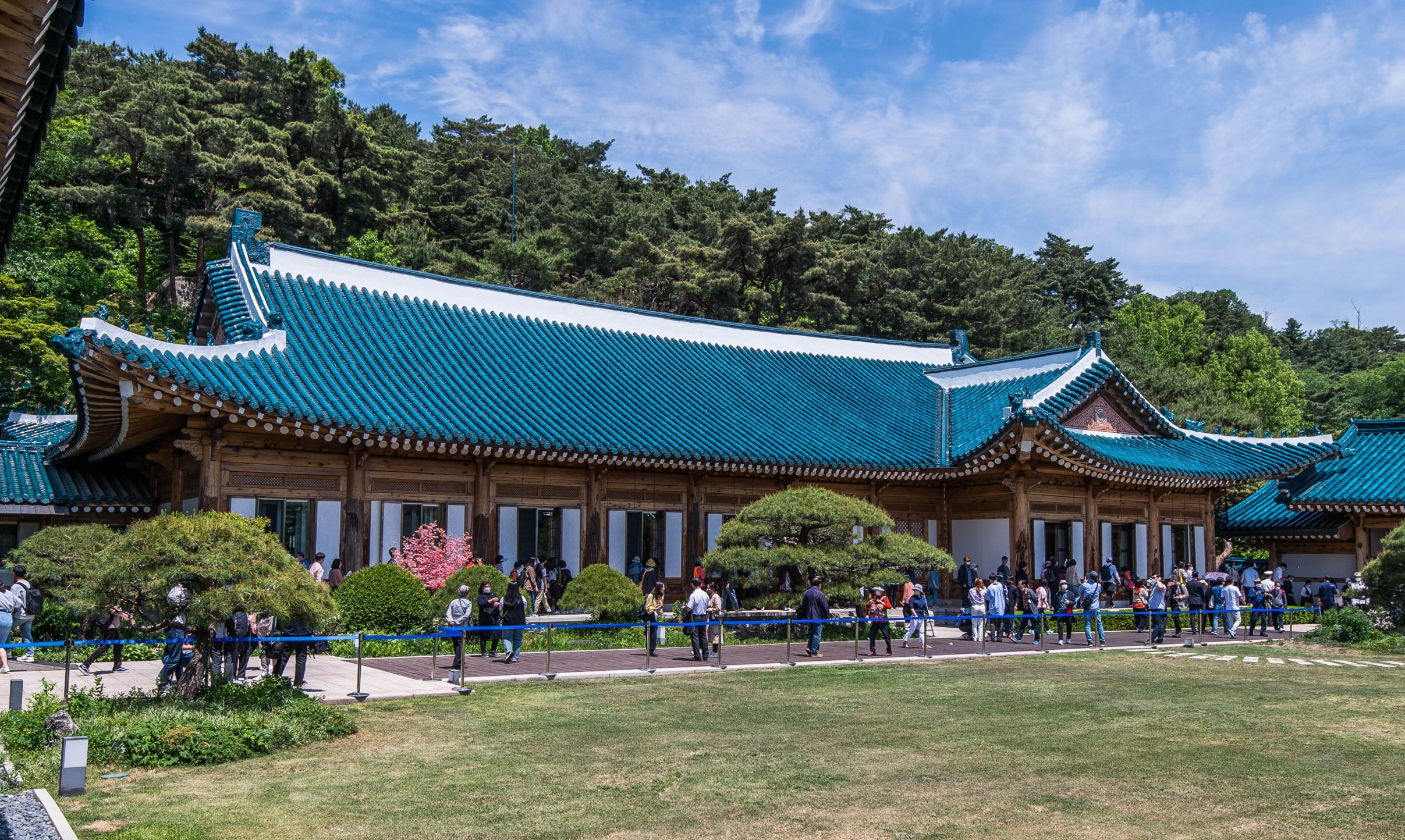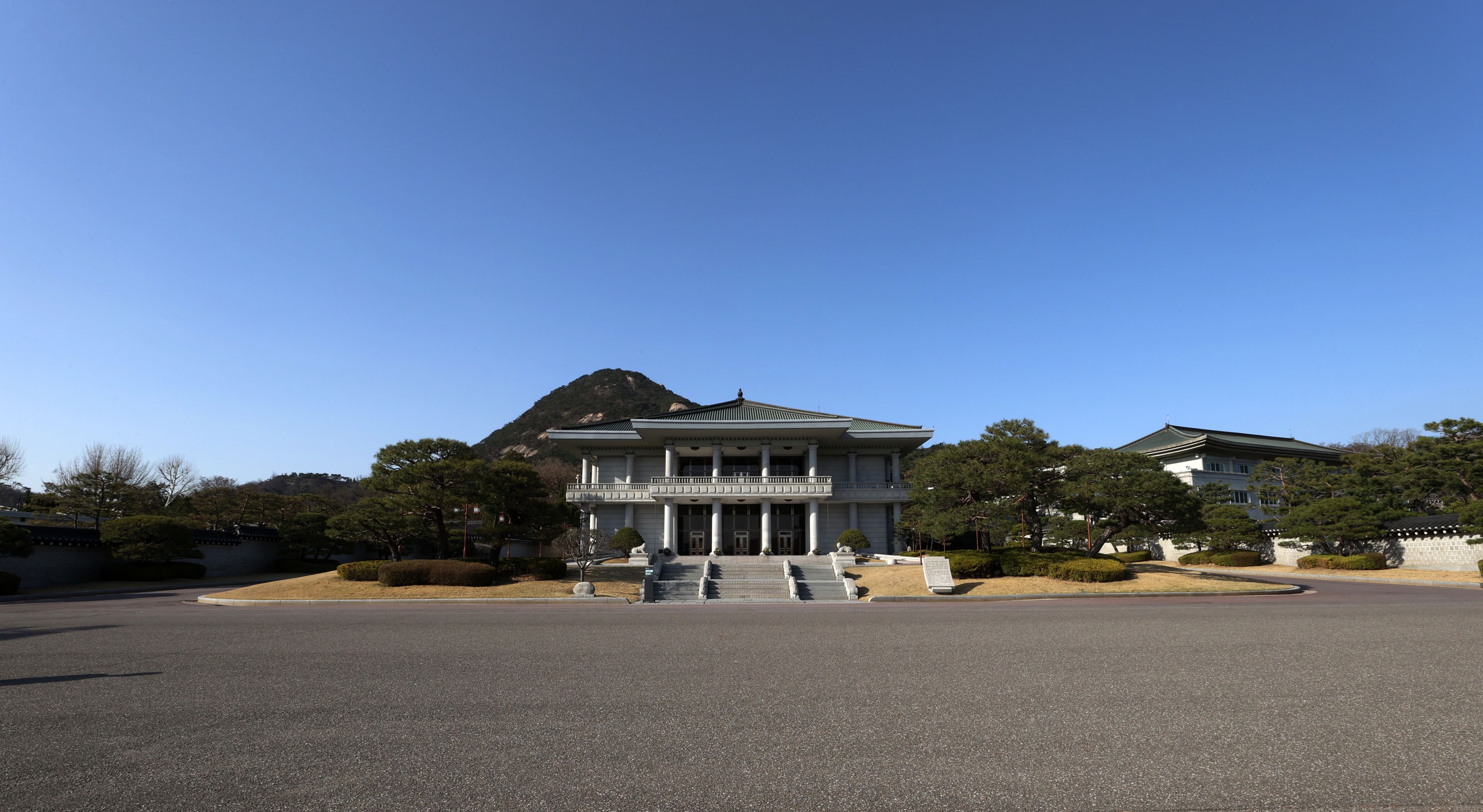[May] Cheong Wa Dae, icon of Korea’s presidential authority, opens to public
Date May 20, 2022
 Musicians and dancers perform Jongmyo Jeryeak, the traditional ancestral rite for the spirits of Joseon kings and queens, in front of Cheong Wa Dae’s main office building on May 10.
Musicians and dancers perform Jongmyo Jeryeak, the traditional ancestral rite for the spirits of Joseon kings and queens, in front of Cheong Wa Dae’s main office building on May 10.
●Cheong Wa Dae has opened to the public 74 years after its completion.
●The former presidential office offers a glimpse into modern Korean history.
The gates of Cheong Wa Dae, the Office of the President until midnight May 9, were opened wide to the public around noon May 10 to reveal traces of the country’s modern history behind its fortress-like walls.
In keeping with President Yoon Suk-yeol’s pledge to return Cheong Wa Dae to the people, the government is now allowing them to walk around the presidential compound, right up to the main office, reception halls and other facilities, including the private residence. After making reservations, visitors can experience firsthand the structures that long symbolized the pinnacle of power in the Republic of Korea. Tours of the interiors will be added at a later date.
The new presidential office has been moved about 5 km south of Cheong Wa Dae to the former Ministry of National Defense’s headquarters in Yongsan-gu. Cheong Wa Dae sits just above the main Joseon Dynasty palace Gyeongbokgung in Jongno-gu.
“The Blue House”
To break away from names tainted by imperial Japan’s governor general and Korea’s deposed first president Rhee Syngman, Rhee’s successor President Yun Po-sun (August 1960-March 1962) sought a new name for the Office of the President. Just as the people of the United States came to call their president’s office and residence the White House, Koreans took inspiration from a key feature of the main structure for the name Cheong Wa Dae, literally “pavilion with blue roof tiles.”
Cheong Wa Dae also came to be called “the Blue House,” which remains an unofficial name. Yuk Young-soo, wife of former President Park Chung-hee (March 1962 to October 1979), reportedly asked government officials to refrain from using that English moniker. However, some still use the acronym BH to refer to the office in internal documents.
Main office
Bongwan, the main office building, is the iconic image of Cheong Wa Dae and appears on the former official presidential seal. It was built in 1991 to replace the old main office, where the governor general resided during Japan’s colonial rule of Korea (1910-1945). The structure houses the president’s office, the conference room Sejong Hall, Chungmu Hall, Baekak Hall and one other banquet room used to receive guests.
But presidents in recent years rarely used Bongwan’s presidential office for day-to-day work since the office complex Yeomingwan for presidential secretaries sits about 10 minutes away by foot.
Former President Moon Jae-in worked inside of Yeomingwan to enable faster communication with his aides. His predecessor Park Geun-hye preferred to meet secretaries and staff inside the private residence, and her predecessors Presidents Lee Myung-bak and Roh Moo-hyun also preferred temporary offices within Yeomingwan.
Yeomingwan
Yeomingwan, about 500 meters from both Bongwan and the official residence, comprises three separate office buildings for the president’s secretaries and other Cheong Wa Dae officials.
Contrary to public perceptions, officials say the buildings are far from being well maintained and equipped and require major repairs at times. In 2013, then-Senior Presidential Secretary for Public Relations Lee Jung-hyun asked the National Assembly to allocate funds to fix a broken ceiling in the office of the senior secretary for economic affairs.
 Sangchunjae / Courtesy of KOREA.net
Sangchunjae / Courtesy of KOREA.net
Sangchunjae, Nokjiwon
Located just north of Yeomingwan is Sangchunjae, a small pavilion in traditional Hanok style. Nokjiwon, the garden just in front, looks resplendent with a fresh green each May.
Completed in 1983, Sangchunjae has been used mostly to entertain guests. Former President Moon frequently hosted receptions for visiting American dignitaries there: then-U.S. President Donald Trump in 2017; his daughter Ivanka Trump, who was a senior advisor to the Trump Administration, in 2018; and George W. Bush in 2019. The former U.S. president was in Korea for a memorial service to honor the late President Roh who had served at the same time he was in office.
In March, outgoing President Moon met incoming President Yoon for dinner at Sangchunjae, and the two exchanged ideas on state affairs.
Chunchugwan
On the east end of the presidential compound is Chunchugwan, which served as the press center for Cheong Wa Dae correspondents.
The building was completed in 1990 to house a large conference room for briefings from the presidential spokesperson and senior secretary for public relations.
The last seven administrations utilized the press center, each assigning a different set of rules for the reporters allowed inside the presidential compound. When Moon Jae-in was president, reporters assigned to the press center could access other parts of Cheong Wa Dae only as part of a press pool covering events held elsewhere in the compound.
Chunchugwan derived its name from the office for recordkeeping that Korean kings maintained for over a millennium from the Goryeo (918-1392) to Joseon (1392-1910) Dynasty.
 Presidential residence
Presidential residence
Official presidential residence
The official presidential residence lies northeast of Yeomingwan and has been described as “the most secretive” place in Cheong Wa Dae.
Completed in 1990, it consists of living quarters for the President and his or her family members, conference rooms, dining rooms, a presidential office and other facilities for secretaries.
 Yeongbingwan / Courtesy of KOREA.net
Yeongbingwan / Courtesy of KOREA.net
Yeongbingwan
Yeongbingwan is the state reception hall used to host official events and large gatherings involving more than 100 guests.
Completed in 1978, it is the oldest of Cheong Wa Dae’s modern structures. Before it was built, presidents hosted guests in a large Hanok-style reception hall constructed in 1967. That “Yeong Bin Gwan” still stands on the grounds of the Shilla Hotel in Jung-gu.
Though Yeongbingwan means “state guest house,” the facilities in Cheong Wa Dae lack overnight accommodations. As a result, many state guests stay in one of Seoul’s hotels.
Seobyeolgwan
Seobyeolgwan, or “West Annex,” is a small house near Cheong Wa Dae Sarangchae, the Museum of Presidential History. The presidential museum actually sits outside the compound, just west of Gyeongbokgung’s wall.
The public knew very little, if anything, about Seobyeolgwan until a 1997 media report revealed that economy ministers, presidential aides and other high-profile government officials periodically held closed-door, off-the-record meetings there. Some of the resultant policies played a crucial role in the country’s economic development.
Though Seobyeolgwan resembles a traditional single-family Korean house from the 1970s or 80s, its remodeled interior contains small conference rooms.
Currently, those wishing to enter the grounds of Cheong Wa Dae should visit the opencheongwadae website (Korean). Reservations can only be made through a personal Naver, Kakao or Toss account.
**If you have any questions about this article, feel free to contact us at kocis@korea.kr.**

The Ministry of Culture, Sports and Tourism's "Korea Here & Now" work can be used under the condition of "Public Nuri Type 1 (Source Indication)."




